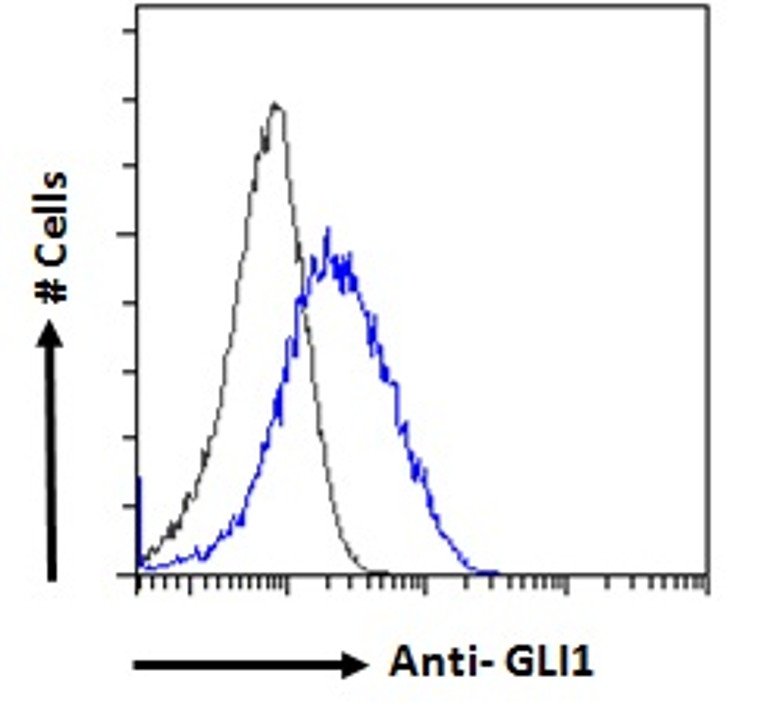| Host: |
Goat |
| Applications: |
Pep-ELISA/IF/FC |
| Reactivity: |
Human/Mouse/Rat/Dog/Cow |
| Note: |
STRICTLY FOR FURTHER SCIENTIFIC RESEARCH USE ONLY (RUO). MUST NOT TO BE USED IN DIAGNOSTIC OR THERAPEUTIC APPLICATIONS. |
| Short Description: |
Goat polyclonal antibody anti-GLI1 (Internal) is suitable for use in ELISA, Immunofluorescence and Flow Cytometry research applications. |
| Clonality: |
Polyclonal |
| Conjugation: |
Unconjugated |
| Isotype: |
IgG |
| Formulation: |
0.5 mg/ml in Tris saline, 0.02% sodium azide, pH7.3 with 0.5% bovine serum albumin. NA |
| Purification: |
Purified from goat serum by ammonium sulphate precipitation followed by antigen affinity chromatography using the immunizing peptide. |
| Concentration: |
0.5 mg/mL |
| Dilution Range: |
IF-Strong expression of the protein seen in the cytoplasm of U2OS cells. 10µg/mlFC-Flow cytometric analysis of HepG2 cells. 10ug/mlELISA-antibody detection limit dilution 1:128000. |
| Storage Instruction: |
Store at-20°C on receipt and minimise freeze-thaw cycles. |
| Gene Symbol: |
GLI1 |
| Gene ID: |
2735 |
| Uniprot ID: |
GLI1_HUMAN |
| Immunogen Region: |
Internal |
| Accession Number: |
NP_005260.1; NP_001153517.1; NP_001161081.1 |
| Specificity: |
This antibody is expected to recognize the reported isoforms (NP_005260.1; NP_001153517.1; NP_001161081.1). |
| Immunogen Sequence: |
TYSQCPRLEHYGQ |
| Post Translational Modifications | Phosphorylated in vitro by ULK3. Acetylation at Lys-518 down-regulates transcriptional activity. Deacetylated by HDAC1. Ubiquitinated by the CRL2(FEM1B) complex, suppressing GLI1 transcriptional activator activity. |
| Function | Acts as a transcriptional activator. Binds to the DNA consensus sequence 5'-GACCACCCA-3'. Regulates the transcription of specific genes during normal development. Plays a role in craniofacial development and digital development, as well as development of the central nervous system and gastrointestinal tract. Mediates SHH signaling. Plays a role in cell proliferation and differentiation via its role in SHH signaling. Isoform 2: Acts as a transcriptional activator, but activates a different set of genes than isoform 1. Activates expression of CD24, unlike isoform 1. Mediates SHH signaling. Promotes cancer cell migration. |
| Protein Name | Zinc Finger Protein Gli1Glioma-Associated OncogeneOncogene Gli |
| Database Links | Reactome: R-HSA-5610780Reactome: R-HSA-5610787Reactome: R-HSA-5632684Reactome: R-HSA-5635851 |
| Cellular Localisation | CytoplasmNucleusTethered In The Cytoplasm By Binding To SufuActivation And Translocation To The Nucleus Is Promoted By Interaction With Stk36Phosphorylation By Ulk3 May Promote Nuclear LocalizationTranslocation To The Nucleus Is Promoted By Interaction With Zic1Isoform 2: Cytoplasm |
| Alternative Antibody Names | Anti-Zinc Finger Protein Gli1 antibodyAnti-Glioma-Associated Oncogene antibodyAnti-Oncogene Gli antibodyAnti-GLI1 antibodyAnti-GLI antibody |
Information sourced from Uniprot.org
12 months for antibodies. 6 months for ELISA Kits. Please see website T&Cs for further guidance







